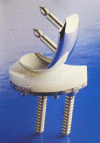A mid term comparison of open wedge high tibial osteotomy vs unicompartmental knee arthroplasty for medial compartment osteoarthritis of the knee
- PMID: 20799991
- PMCID: PMC2940897
- DOI: 10.1186/1749-799X-5-65
A mid term comparison of open wedge high tibial osteotomy vs unicompartmental knee arthroplasty for medial compartment osteoarthritis of the knee
Abstract
Background: The choice of surgical treatments for unicompartmental osteoarthritis (OA) of the knee is still somewhat controversial. Midterm results from cases treated using unicompartmental knee arthroplasty (UKA) or open wedge high tibial osteotomy (OWHTO) were evaluated retrospectively.
Methods: Twenty-seven knees of 24 patients with varus deformities underwent OWHTO and 30 knees of 18 patients underwent UKA surgeries for the treatment of medial compartmental osteoarthritis (OA). The KSS score, FTA, range of motion and complications were evaluated before and after surgery.
Results: The preoperative mean KSS scores were 49 points in the OWHTO group and 62 in the UKA group which improved postoperatively to 89 (excellent; 19 knees, good; 8 knees), and 88 (excellent; 25, good; 4, fair; 1), respectively. There was no significant difference between the OWHTO and UKA scores. Seventeen patients in the OWHTO group could sit comfortably in the formal Japanese style after surgery. The preoperative mean FTA values for the OWHTO and UKA groups were 182 degrees and 184, and at follow-up measured 169 and 170, respectively. In the UKA group, the femoral component and the polyethylene insertion in one patient was exchanged at 5 years post-surgery and revision TKAs were performed in 2 cases. In the OWHTO group, one tibial plateau fracture and one subcutaneous tissue infection were noted.
Conclusions: Treatment options should be carefully considered for each OA patient in accordance with their activity levels, grade of advanced OA, age, and range of motion of the knee. OWHTO shows an improved indication for active patients with a good range of motion of the knee.
Figures




References
-
- Billing A, Scott FD, Camargo PM, Hofmann AA. High tibial osteotomy with a calibrated osteotomy guide, rigid internal fixation, and early motion. Long-term follow-up. J Bone Joint Surg Am. 2000;82:70–79. - PubMed
-
- Carr A, Keyes G, Miller R, O'Connor J, Goodfellow J. Medial unicompartmental arthroplasty. A survival study of the Oxford meniscal knee. Clin Orthop. 1993;295:205–213. - PubMed
-
- Coventry MB, Ilstrup DM, Wallrichs SL. Proximal tibial osteotomy. A critical long-term study of eighty-seven cases. J Bone Joint Surg Am. 1993;75:196–201. - PubMed
LinkOut - more resources
Full Text Sources

